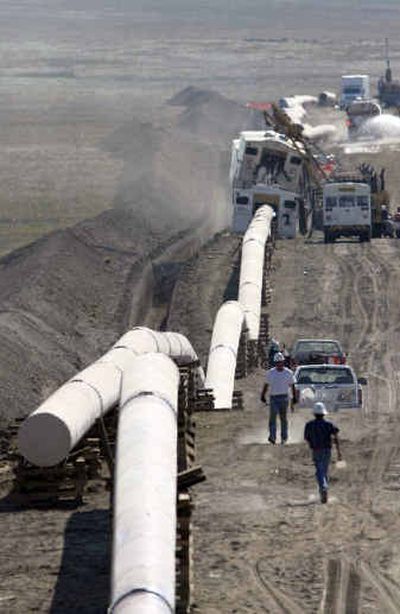Cold reality

If the law of supply and demand really drives commodity prices, then something seems amiss in the natural gas market.
Natural gas futures are trading on the New York Mercantile Exchange at prices roughly 50 percent higher than a year ago, even though government data show that demand has declined and pre-winter storage levels are well above historical norms. This is in stark contrast with the oil market, where prices are higher amid global output limitations and unexpectedly strong consumption.
The rise in natural gas prices has coincided with a big increase in trading by hedge funds and other speculators. And in a letter being sent today to lawmakers, an organization representing industrial users of gas says the market has become vulnerable to manipulation.
Whatever the cause, homeowners who rely on natural gas are feeling the pinch: The Energy Department predicts they will spend on average $1,000 this winter on heating bills, a 15 percent increase.
So are manufacturers of chemicals, plastics and resins, for whom natural gas is both a raw material and an energy source. They are complaining to Congress about their fuel costs after a steep rise in prices in September and October.
The jump in natural gas prices has not received as much media attention as the oil-price run-up, but consumer advocates and industry groups say it is more troubling from their perspective. Most natural gas pumped to American factories and homes is produced domestically and shouldn’t be as vulnerable to the geopolitical turmoil that has roiled oil markets.
“The natural gas market price is no longer being set by consumers’ demands for the physical supply of gas,” Paul Cicio, the executive director of the Industrial Energy Consumers of America, said in a letter to be sent today to members of Congress.
“Instead of the market serving the greater public good, it serves the investment interests of ever-growing unregulated billion-dollar hedge funds that are completely disconnected from the consumer and manufacturing market.”
Cicio’s organization represents companies ranging from Dow Chemical Co. to Bayer Corp. to BASF Corp. He said Nymex needs to place tighter controls on intraday volatility, reduce the number of natural gas contracts any single trading entity can own and give more enforcement responsibilities to the Commodity Futures Trading Commission.
Relaxed federal oversight has helped turn Nymex into an environment that is too friendly to speculators and “susceptible to manipulation,” Cicio said.
Nymex Holdings Inc. is the parent of the world’s largest energy futures exchange, whose members include brokerages such as ABN Amro Inc., trading units of energy producers such as El Paso Merchant Energy LP, and investments banks such as Goldman Sachs & Co. The exchange’s new president, James E. Newsome, is the former chairman of the CFTC.
Nymex Holdings earned $11.6 million in the first half of the year on revenues of $109.7 million. But judging by the $2 million paid for the most recent sale of a seat on the exchange in October, its members’ earnings potential is even higher.
Average daily trading volume for natural gas futures has surged 16-fold over the past 10 years, according to Nymex data. By comparison, oil futures trading volume has doubled over the same period.
At the same time, commercial traders — utilities and industrial consumers who use futures markets to hedge against price movements in the spot market — are not as dominant in the market as they once were. The proportion of noncommercial traders such as hedge funds and individual speculators fluctuated at the Nymex during the mid- to late-1990s, but has trended steadily higher since 2001, according to CFTC data.
For example, in November 2001 noncommercial traders accounted for about 10 percent of big holders of multiple gas contracts. They now account for nearly 40 percent.
Critics say the proliferation of noncommercial trading is a major reason why natural gas prices have become so volatile.
Nachamah Jacobovits, a Nymex spokeswoman, said it’s the reverse: Increased volatility is luring more traders to the market, including both speculators and commercial entities seeking to offset their risk in the spot market. “People who don’t hedge get hurt,” Jacobovits said.
“There’s no question that natural gas is a very volatile market,” Jacobovits said, but “we have a great deal of resources devoted to monitoring it.”
Indeed, the CFTC, in coordination with Nymex, completed in August a seven-month investigation into surging natural gas prices last winter and concluded there was no evidence that markets were manipulated.
The agency said prices rose sharply — above $7 per 1,000 cubic feet in December 2003 — because of colder-than-expected weather in the Northeast and predictions made prior to the home-heating season that U.S. inventories of natural gas would be tight.
While some energy analysts argue there is a complicated logic underpinning today’s soaring natural gas prices, others point to market speculation, pure and simple.
“The natural gas rally was totally spec driven,” James Cordier, head trader at Liberty Trading Group Inc. of Tampa, Fla. said, using the industry vernacular for speculators.
Marshall Steeves, an energy analyst at the New York-based brokerage Refco Group Inc., also said the intense surge in prices has defied rational market behavior. “The run-up was crazy, I thought,” Steeves said.
Futures prices are still up about 50 percent from a year ago, at $7.12 per 1,000 cubic feet.